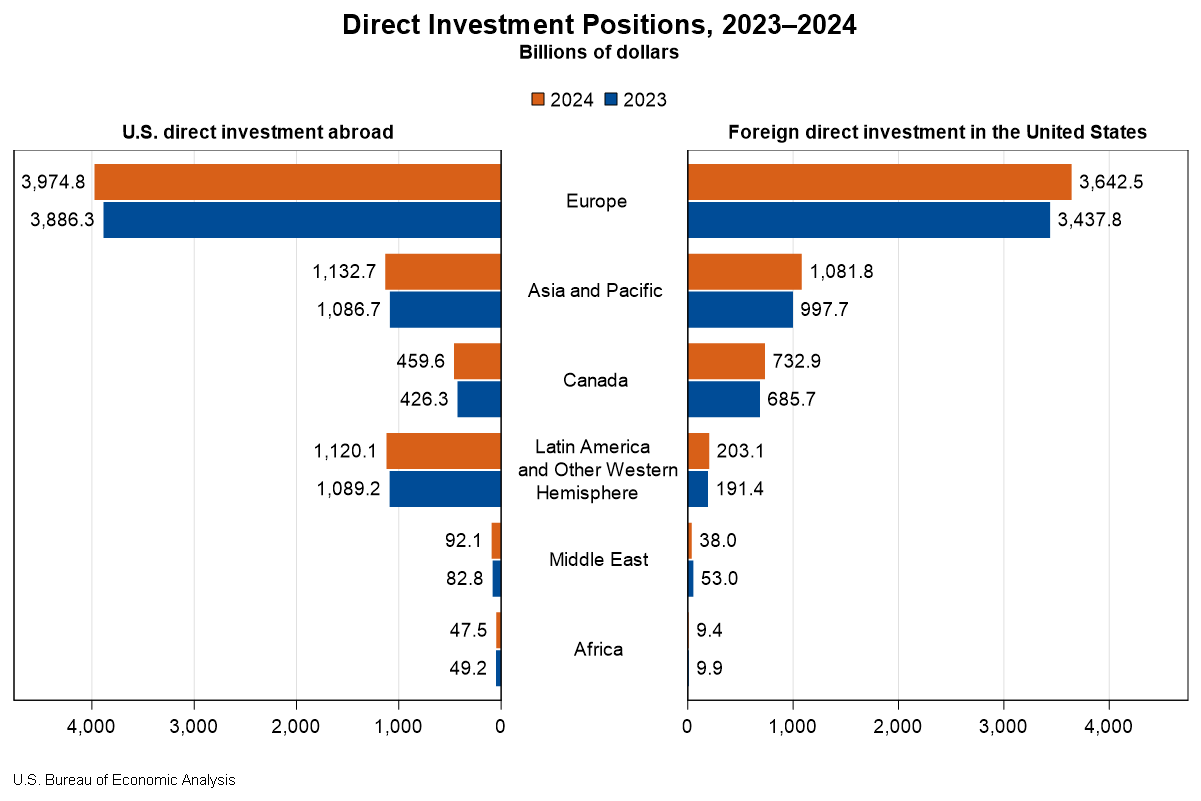Bureau of Economic Analysis
Direct Investment by Country and Industry, 2024
The U.S. direct investment abroad position, or cumulative level of investment, increased $206.3 billion to $6.83 trillion at the end of 2024, according to statistics released today by the U.S. Bureau of Economic Analysis. The increase was led by an $88.4 billion increase in the position in Europe, primarily in Luxembourg and Germany. By industry, manufacturing affiliates had the largest increase, led by manufacturing of computers and electronic products.
The foreign direct investment in the United States position increased $332.1 billion to $5.71 trillion at the end of 2024. The increase was led by a $204.7 billion increase in the position from Europe, which reflected a $52.9 billion increase from the United Kingdom and a $39.7 billion increase from Germany. By industry, affiliates in manufacturing increased the most.
Principal Federal Economic Indicators
Noteworthy
- 2025 News Release Schedule
- Innovation at BEA
- 2025 Annual Updates
- New! Services Trade Data for More Countries
- Data Tool: Trade in Value Added
- Distribution of State Personal Income
- Updated: RIMS II Regional Multipliers
- Arts and Culture
- Space Economy
- FDI Now in State BEARFACTS
- Quick Guide: Price Indexes
The Latest
BEA Joins the FSRDC Network: New Secure Locations Now Available for Researchers
For the first time, approved academics and other researchers will be able to access the Bureau of Economic Analysis’ confidential, company-specific trade and investment data from secure locations around the country, making it more convenient for them to do research.
April 2019 Trade Gap is $50.8 Billion
The U.S. monthly international trade deficit decreased in April 2019 according to the U.S. Bureau of Economic Analysis and the U.S. Census Bureau. The deficit decreased from $51.9 billion in March (revised) to $50.8 billion in April, as imports decreased more than exports. The previously published March deficit was $50.0 billion. The goods deficit decreased $1.0 billion in April to $71.7 billion. The services surplus increased $0.1 billion in…
U.S. International Trade in Goods and Services, Annual Revision
The U.S. monthly international trade deficit decreased in April 2019 according to the U.S. Bureau of Economic Analysis and the U.S. Census Bureau. The deficit decreased from $51.9 billion in March (revised) to $50.8 billion in April, as imports decreased more than exports. The previously published March deficit was $50.0 billion. The goods deficit decreased $1.0 billion in April to $71.7 billion. The services surplus increased $0.1 billion in…
U.S. International Trade in Goods and Services, April 2019
The U.S. monthly international trade deficit decreased in April 2019 according to the U.S. Bureau of Economic Analysis and the U.S. Census Bureau. The deficit decreased from $51.9 billion in March (revised) to $50.8 billion in April, as imports decreased more than exports. The previously published March deficit was $50.0 billion. The goods deficit decreased $1.0 billion in April to $71.7 billion. The services surplus increased $0.1 billion in…
Personal Income Rises In April
Personal income increased 0.5 percent in April after increasing 0.1 percent in March. Wages and salaries, the largest component of personal income, increased 0.3 percent in April after increasing 0.4 percent in March.
Personal Income and Outlays, April 2019
Personal income increased 0.5 percent in April after increasing 0.1 percent in March. Wages and salaries, the largest component of personal income, increased 0.3 percent in April after increasing 0.4 percent in March.
GDP Increases in First Quarter
Real gross domestic product increased 3.1 percent in the first quarter of 2019, according to the “second” estimate released by the Bureau of Economic Analysis. The growth rate was 0.1 percentage point lower than the “advance” estimate released in April. In the fourth quarter of 2018, real GDP rose 2.2 percent.
Gross Domestic Product, 1st quarter 2019 (second estimate); Corporate Profits, 1st quarter 2019 (preliminary estimate)
Real gross domestic product (GDP) increased at an annual rate of 3.1 percent in the first quarter of 2019, according to the "second" estimate released by the Bureau of Economic Analysis. In the fourth quarter, real GDP increased 2.2 percent.
Check Out the Buying Power in Your Metro Area
Interested in comparing buying power in your metropolitan area to another? Then, you’ll want to look at the Bureau of Economic Analysis’ latest batch of regional price indexes.
Some highlights from BEA’s recent news release, featuring our 2017 Regional Price Parities:
Real Personal Income for Metropolitan Areas, 2017
The percent change in real metropolitan area personal income ranged from 14.8 percent in Midland, MI to -5.9 percent in Enid, OK.




